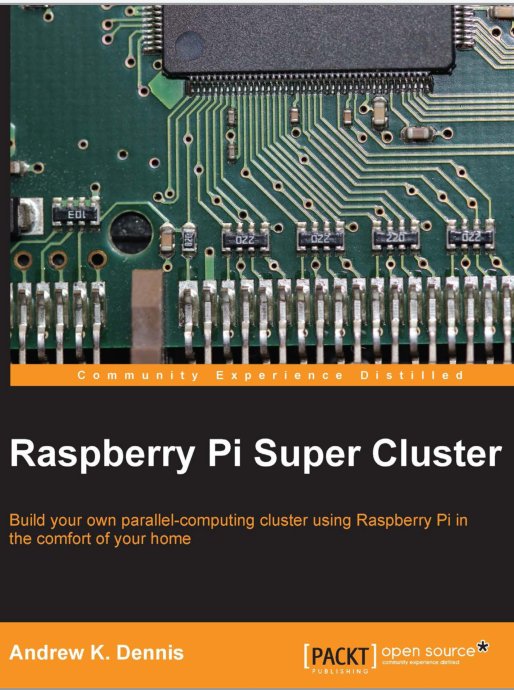E-Book description:
Have you ever read about parallel computing clusters and supercomputing, and
wondered how to do it at home?
Do you have a number of Raspberry Pis and don't know what to do with them?
Then this is the book for you!
The field of parallel computing is certainly an exciting one. With the introduction of the
Raspberry Pi, building a cluster at home is even easier. Hobbyists can now construct a
small parallel computing cluster at low cost and using minimal physical space.
This book will walk you through building a parallel computing cluster using two
Raspberry Pis and commodity off-the-shelf hardware.
Having set up your cluster, you will explore parallel computing paradigms such as
MPI and MapReduce through exciting software projects.
Using MPICH and the C programming language, step-by-step guides will walk
you through writing your own MPI-based applications. You will then test these in
parallel on your two Raspberry Pis.
Following this, MapReduce will be examined through Apache Hadoop, which
you will install and set up. You will then learn to interact with Hadoop by writing
programs in Java.
Finally Raspberry Pi Super Cluster provides you with some fun jump-off points
where you can explore the topics discussed in the book in further detail.
Having completed the various chapters' projects, you will have gained a basic
knowledge of parallel computing and how it can be implemented on Raspberry Pi.
E-Book Author:
Andrew K. Dennis
E-Book Table of Contents:
Preface….1
Chapter 1: Clusters, Parallel Computing, and
Raspberry Pi – A Brief Background….7
A very short history of parallel computing….8
Supercomputers….8
Multi-core and multiprocessor machines….9
Commodity hardware clusters….10
Cloud computing….11
Big data….11
Raspberry Pi and parallel computing….12
Programming languages and frameworks….13
Summary….14
Chapter 2: Setting Up your Raspberry Pi Software and
Hardware for Parallel Computing….15
Setting up our work environment….15
HDMI-capable monitor or VGA/DVI monitor and adapter….16
USB keyboard and mouse….16
Two micro-USB power units….16
A desk-mounted power strip with both USB and mains outlets (optional)….17
Three Ethernet/RJ45 network cables….17
A small network switch….18
An existing Internet connection….18
Two SD cards that are compatible with the Raspberry Pi….18
Housing units for the Raspberry Pi boards and Lego (optional)….19
USB hard drives (optional)….19
Future expansion and a scalable setup….19
Completing the initial setup….20
Using an SD card as our Raspberry Pi's storage device….21
SD card setup….21
Formatting our card….22
Mac OS X SD card formatting instructions….22
Windows 8 SD card formatting instructions….23
Linux instructions for SD card formatting….24
BerryBoot version 2….25
Downloading the BerryBoot version 2 ZIP file….26
Mac OS X….26
Windows 8….26
Linux….26
Starting up the Raspberry Pi….27
The installation process….28
Installation complete….31
Testing SSH and setting up keys….31
Connecting via SSH….32
Mac OS X and Linux users….32
Windows 8 users with PuTTY….33
Setting up your SSH RSA keys….34
The ssh-agent and ssh-add tools….36
SSH setup complete….36
Wrapping up….36
Editing text files on Raspbian….37
Installing Fortran….37
Terminal multiplexing with Screen….38
Summary….40
Chapter 3: Parallel Computing – MPI on the Raspberry Pi….41
MPI – Message Passing Interface….41
MPI implementations – MPICH and OpenMPI….42
Creating an environment and downloading MPICH….43
Building and installing MPICH….44
Configuring your Raspberry Pi to run
with MPICH….45
Testing our MPICH installation….46
Building our second Raspberry Pi….46
Windows 8….47
Mac OS X….48
Linux….49
Powering up the second Raspberry Pi….51
RSA key setup for SSH….51
Writing an MPI-based application….53
MPI – point-to-point communication….55
Summary….59
Chapter 4: Hadoop – Distributed Applications on the Raspberry Pi 61
A brief introduction to Apache Hadoop….61
Installing Java….62
Installing Apache Hadoop….63
Hadoop configuration….64
Testing our Hadoop server….68
Setting up our second Raspberry Pi….69
Summary….73
Chapter 5: MapReduce Applications with Hadoop and Java….75
MapReduce….75
MapReduce in Hadoop….77
HDFS – The Hadoop distributed file system….78
The WordCount MapReduce program….79
Testing our application….82
Summary….84
Chapter 6: Calculate Pi with Hadoop and MPI….85
Monte Carlo simulators….85
A Hadoop application to calculate Pi….86
Pi with C language and MPI….88
Summary….91
Chapter 7: Going Further….93
Booting from an external USB HDD….93
Building a Lego enclosure….95
Experimenting with MPI and Fortran….97
Power for multiple devices….98
USB wall plates….98
Battery power….99
Using a PC power supply….99
Power over Ethernet….100
Summary….100
Appendix….101
Fortran and C/C++….101
MPI, Hadoop, and parallel computing….102
Raspberry Pi cases and clusters….102
Index 105


